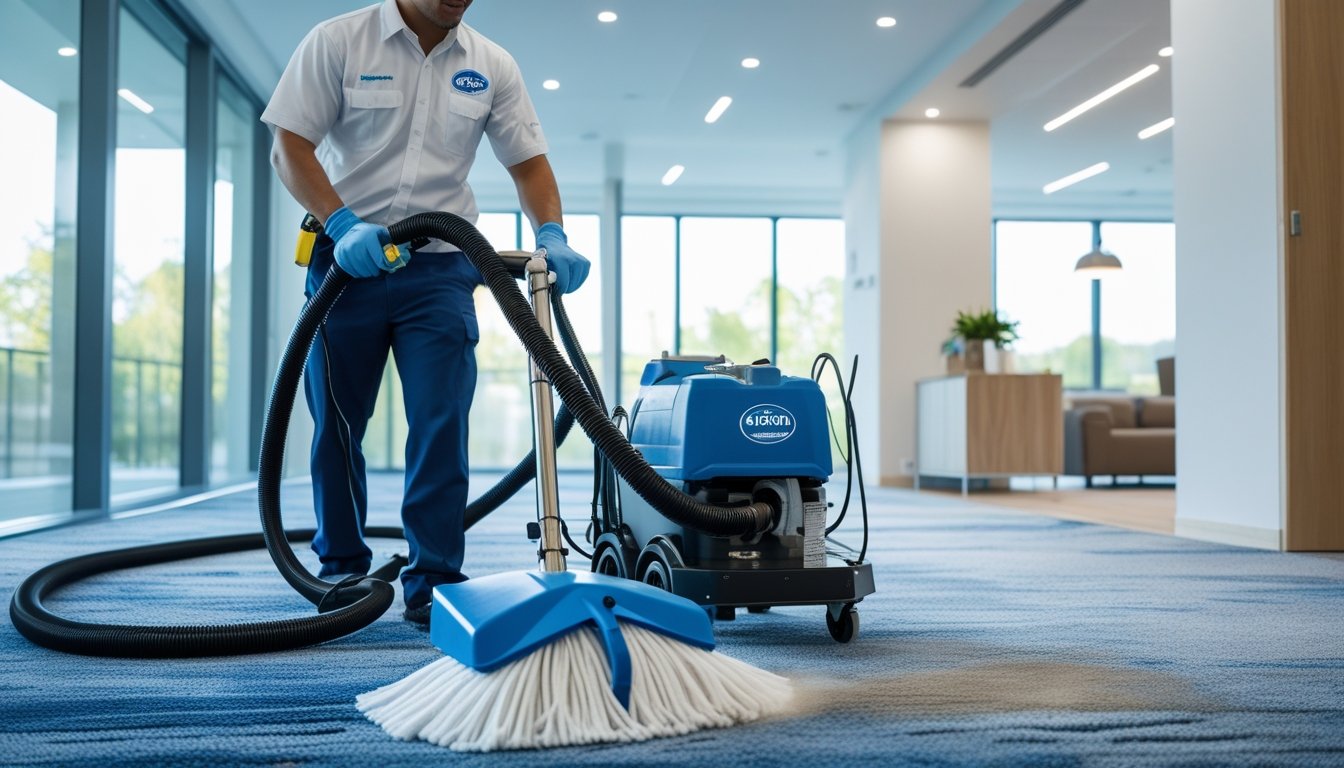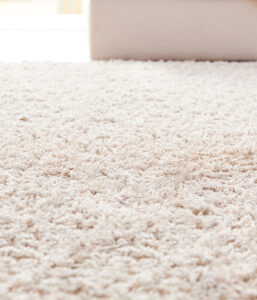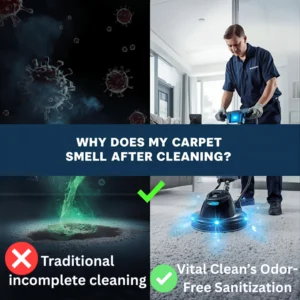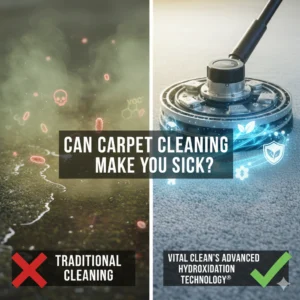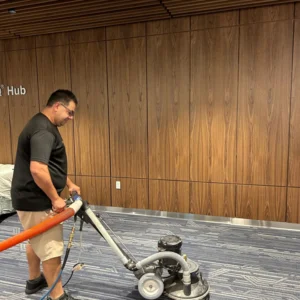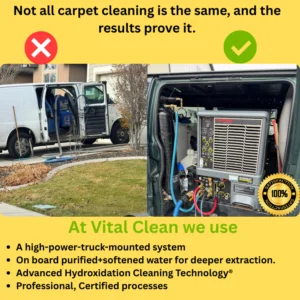If you want your carpets to feel truly fresh and healthy, professional carpet sanitization is the way to go. This goes beyond a regular clean—removing allergens, bacteria, and mold without leaving behind any harsh chemicals or residues.
A deep sanitization makes your home feel safer and more comfortable for everyone, including kids and pets. Using advanced, eco-friendly technology, it tackles dirt and germs that everyday vacuuming just can’t reach.
The difference isn’t just in how your carpets look—it’s in the air you breathe too. Whether you’re dealing with pets, allergies, or just want a healthier home, professional carpet sanitization ensures your carpets get the thorough care they deserve.
What Is Professional Carpet Sanitization?
Professional carpet sanitization means more than just making your carpet look clean. It focuses on removing harmful germs, allergens, and bacteria that regular cleaning might miss.
This process improves your carpet’s health and gives you fresher, safer indoor air. Sanitization uses special solutions and equipment to kill microbes and prevent their return.
It is an important step to keep your home healthy, especially if you have pets, kids, or allergies.
Definition and Key Features
Carpet sanitization targets germs and allergens deep in your carpet fibers. It uses EPA-registered sanitizers that kill bacteria, viruses, mold spores, and dust mites.
Key features include:
- Deep treatment: Reaches below surface dirt
- Non-toxic products: Safe for children and pets
- Odor elimination: Removes smells caused by bacteria and mold
- Residue-free: Leaves no harmful leftovers
Advanced techniques like Vital Clean’s Hydroxidation Cleaning Technology® achieve a deep clean without harsh chemicals. Your carpet looks great and supports a healthier home.
Differences Between Cleaning and Sanitization
Cleaning removes visible dirt, stains, and dust from your carpet. It restores the look and texture, but it doesn’t always kill germs or allergens.
Sanitization focuses on killing bacteria, viruses, and fungi. It also reduces allergens like dust mites and pet dander and eliminates odors caused by microbes.
Think of cleaning as brushing off surface dust, while sanitizing disinfects the carpet to stop the spread of germs. Both steps work best together to keep your carpet fresh and healthy.
Why Regular Sanitization Matters
Over time, carpets trap invisible allergens, mold, and bacteria. These can affect your indoor air quality and trigger allergies or respiratory issues.
Regular sanitization keeps your carpet hygienic and protects your family’s health. It also extends the life of your carpet by preventing mold growth.
Vital Clean uses safe, eco-friendly products that protect your home and the environment. Scheduling regular sanitization ensures your carpet stays as healthy as it looks.
Benefits of Professional Carpet Sanitization
Professional carpet sanitization does more than just make your carpet look clean. It removes harmful germs and allergens, tackles odors, helps your carpet last longer, and boosts the air quality in your home or office.
Health and Allergy Reduction
Sanitizing your carpet removes dust mites, mold spores, and bacteria that can cause allergic reactions. These tiny irritants often hide deep in carpet fibers, making regular vacuuming not enough.
Professional services use advanced methods to kill these allergens without leaving harmful residues. This means fewer sneezes, less itching, and a lower chance of respiratory issues for your family.
If you or someone in your home suffers from asthma or allergies, sanitization can provide noticeable relief by reducing triggers that build up in carpets.
Odor Elimination
Carpets trap odors from pets, spills, and everyday dirt. Regular cleaning only masks these smells but doesn’t eliminate them.
Professional sanitization targets the source. Using deep-cleaning tech and eco-friendly solutions, the process removes bacteria and organic matter that cause bad odors permanently.
Your carpet will smell fresher and your whole space will feel cleaner. This is especially helpful if you have pets or high foot traffic.
Longevity of Carpets
Sanitization protects the fibers of your carpet. Dirt, bacteria, and allergens can break down carpet material, making it wear out faster.
Removing these harmful elements slows down damage, keeping your carpet looking newer longer. Regular sanitizing also preserves the carpet’s color and texture.
This means you won’t need to replace your carpet as often, saving you money over time.
Improved Indoor Air Quality
Carpets often hold airborne particles that circulate every time you walk or vacuum. When left untreated, these particles re-enter the air you breathe inside your home or office.
Sanitizing your carpets removes these trapped contaminants, helping lower dust and pollutant levels. This improves indoor air quality, making your environment healthier.
Cleaner carpets mean cleaner air for your family to breathe every day.
Common Methods Used in Carpet Sanitization
Carpet sanitization uses several proven methods to remove dirt, germs, and allergens. These methods focus on deep cleaning and killing bacteria without leaving harmful residues.
You can choose a method based on your carpet type and cleaning needs.
Hot Water Extraction
Hot water extraction, often called steam cleaning, uses hot water mixed with cleaning solutions. The water is sprayed into your carpet under high pressure, breaking down dirt and grime deep in the fibers.
Powerful suction then removes the water along with the loosened dirt. This method penetrates deep to remove allergens and bacteria effectively.
It’s especially good for homes with pets or allergy sufferers because it cleans thoroughly without harsh chemicals. The carpet may take a few hours to dry, but the clean is deep and long-lasting.
Dry Sanitization Technology
Dry sanitization uses specialized powders or foams with low moisture. These agents are spread on your carpet and then gently worked in.
The powders capture dirt and germs as they dry, which are then vacuumed away. This method is faster because no drying time is needed.
It suits commercial spaces or busy homes where quick turnaround is important. Dry sanitization uses less water, making it eco-friendly and safe for delicate carpets.
Steam Cleaning Process
Steam cleaning uses high-temperature steam to kill bacteria, mold, and dust mites deep inside your carpet fibers. The steam sanitizes and loosens dirt for easier removal.
This process avoids harsh chemicals, relying on heat to disinfect. It’s very effective in removing tough stains and odors.
You’ll notice fresher carpets and better air quality. The main downside is the drying time, but you get cleaner carpets without residual chemicals.
How the Carpet Sanitization Process Works
Sanitizing your carpet involves careful steps to remove dirt, bacteria, and allergens without leaving harmful residue. This process ensures your carpet is clean, healthy, and safe for your home.
Every step targets problem areas and restores your carpet’s freshness.
Initial Inspection
First, a thorough inspection of your carpet identifies stains, spots, and areas with heavy soil or odor. This helps tailor the cleaning plan to your carpet’s specific needs.
The technician checks for damage or wear that may affect the process. They also look for pet urine or mold, which require extra attention.
Knowing these details upfront means you get the right treatment without wasting time or risking damage.
Pre-Treatment and Spot Removal
Before deep cleaning, problem spots like stains or pet accidents get treated with special pre-sprays. These break down tough soils and make them easier to remove.
Pre-treatment uses eco-friendly products safe for kids and pets but tough on dirt. This step also helps neutralize strong odors.
The goal is to lift dirt from the fibers and prepare your carpet for sanitizing without harsh chemicals.
Application of Sanitizing Agents
Next, safe, EPA-registered sanitizing agents get applied. These kill bacteria, viruses, mold, and allergens trapped in your carpet.
Vital Clean uses advanced hydroxidation technology powered by ozonated water to boost disinfecting power. This method cleans deeply but gently, avoiding harsh chemicals that can irritate sensitive skin.
The sanitizer works quickly and breaks down into harmless water and oxygen, leaving no residue.
Final Rinse and Drying
The last step is a thorough rinse to remove soaps, soils, and sanitizing agent leftovers. Proper rinsing avoids residue that can attract dirt again.
Special rotary extraction machines remove excess moisture and clean water to help your carpet dry faster. This also ensures no cleaning chemicals stay trapped inside.
Drying time varies but usually takes a few hours. Good airflow speeds up drying and prevents mold or mildew growth.
Choosing a Professional Carpet Sanitization Service
Finding the right carpet sanitization service is essential for a clean, healthy home. You want a company that uses safe, effective methods, has the right experience, and cares about the environment.
These factors help get the best results without risking your family’s health or your carpet’s condition.
What to Look for in a Service Provider
When choosing a service, focus on companies that prioritize customer satisfaction. Look for clear communication, punctuality, and professionalism.
You want a team that explains their process and answers your questions honestly. Check for services that use advanced cleaning technologies like steam or hydroxidation.
These methods remove dirt, bacteria, and allergens deep within the carpet fibers. Avoid companies that rely only on surface cleaning.
Reading customer reviews helps you see if a company consistently delivers great results. Also, ask about guarantees or follow-up support to protect your investment.
Certifications and Experience
Choose professionals with certifications from trusted organizations like the IICRC. These credentials mean the technicians are trained and follow industry standards.
Experience matters too. A local, established company knows the specific needs of your area’s homes and carpets.
For example, Vital Clean Carpet Cleaning in Utah offers same-day appointments and a high-touch approach led by trained local experts. Experienced cleaners know how to handle different carpet fabrics safely and choose the best sanitization method.
This protects your carpet’s texture and colors while ensuring deep cleaning.
Eco-Friendly Practices
An eco-friendly carpet sanitization service uses non-toxic, residue-free products that are safe for kids and pets. These companies minimize water and energy use during cleaning.
Look for services that emphasize sustainability through green fleet routing and water-efficient methods. For example, Vital Clean uses Advanced Hydroxidation Cleaning Technology® powered by ozonated water to clean deeply without harsh chemicals.
Choosing an eco-conscious company protects your family’s health by removing allergens and bacteria without adding harmful residues. It also helps reduce your home’s environmental impact.
Frequency and Recommended Schedule
How often you schedule professional carpet sanitization depends on how much use your carpet gets and changes in the weather. Keeping your carpet clean at the right time helps prevent damage and keeps your home healthier.
Factors Affecting Frequency
If your carpet is in a busy area like the living room, hallway, or entryway, you’ll need to clean it more often. These spots see more dirt, dust, and germs.
For high-traffic areas, professional sanitization every 3 to 6 months is a smart choice. Pets, kids, or anyone with allergies also mean more frequent cleanings.
Dirt, pet dander, and bacteria build up faster in these homes. If you have someone with asthma or allergies, scheduling cleanings on the shorter side helps improve air quality.
Seasonal Considerations
Different times of the year bring specific challenges. In Utah, winter and spring often mean more dirt, salt, and moisture tracked inside.
This can encourage mold and bacteria growth in your carpet. After heavy snowfall or rainy months, plan for a professional cleaning soon to avoid long-term damage.
Summer and early fall usually see less moisture, so sanitizing every 6 months can work fine during these seasons. Using eco-friendly, residue-free cleaning during these times ensures your carpet stays fresh without harsh chemicals that might affect sensitive family members or pets.
Preparing for Your Carpet Sanitization Appointment
Getting ready for your carpet sanitization helps the process go smoothly. It also ensures you get the best results.
Create space, protect your belongings, and follow simple steps before the pros arrive.
Clearing and Organizing the Space
Before your appointment, clear the area around your carpets. Move furniture like chairs, tables, and small items out of the way.
This gives the cleaning team better access to every spot. It also helps avoid damage.
Remove fragile decorations, toys, or anything on the carpet that could get wet or stained. Keep pets in a separate room during cleaning for their safety and comfort.
Make clear pathways so the technicians can bring in equipment easily. Tidying up saves time and lets the crew focus on cleaning.
Pre-Appointment Instructions
Vacuum your carpet before the appointment if asked. This removes loose dirt and lets the sanitization work better.
If you have any tough stains or pet odors, tell your cleaning specialist. They can then plan the right treatment.
Wear comfortable clothes, as the process may take a few hours. Keep kids and pets away until the carpet dries completely.
Confirm your appointment time the day before. This helps you avoid delays and ensures the team arrives ready.
Aftercare Tips for Sanitized Carpets
Keep your carpets dry and clean after professional sanitization to maintain their look and health. Focus on good airflow to speed drying and follow simple cleaning habits to keep dirt and stains away.
Proper Drying and Ventilation
After your carpet is sanitized, dry it quickly to avoid mold and odors. Open windows and doors to create good airflow.
Use fans or a dehumidifier in rooms that hold moisture. Avoid walking on damp carpets until they’re dry.
Keep heavy curtains or rugs off the carpeted areas so air can circulate. If drying takes longer than a day, check for wet spots and air them out more.
Regular Maintenance Suggestions
Vacuum your carpets at least once a week. Focus on high-traffic areas where dirt builds up faster.
Spot clean spills right away using safe, gentle products. This prevents stains from setting in.
Schedule professional cleanings every 6 to 12 months, depending on your home’s traffic and pets. In Utah areas like Salt Lake City or Draper, regular care helps protect carpet fibers from dust and allergens.
Use protective mats at doorways to limit dirt entry. These habits help your sanitized carpet stay healthy and look great longer.
Professional Carpet Sanitization Cost Factors
When you consider professional carpet sanitization, the price depends mainly on the carpet’s size and type, plus the service package you choose. These factors affect how much time, effort, and materials are needed to clean and sanitize your carpet.
Size and Type of Carpet
Larger carpets cost more because they need more cleaning solution, water, and labor. For example, a small area rug will cost much less than wall-to-wall carpeting in your living room or office.
The carpet’s material also changes the price. Natural fibers like wool need special care and gentle cleaning, which can raise costs.
Synthetic carpets, such as nylon or polyester, usually need less expensive treatments. Thick, high-pile carpets may take longer to clean and sanitize than low-pile carpets.
Service Package Options
Sanitization services come in different packages based on the level of cleaning and extra treatments. A basic sanitization might include deep steam cleaning with eco-safe solutions that kill bacteria and allergens.
Advanced packages can add stain removal, odor treatment, and protection coatings. Some packages include allergen relief or mold remediation.
Choosing a package with more features will cost more upfront. These options can extend your carpet’s life and improve health at home.
| Package Level | What’s Included | Typical Use Cases |
| Basic Sanitization | Deep clean, eco-friendly sanitizers | Routine health-focused cleaning |
| Enhanced Cleaning | Stain and odor treatment | Pets, kids, high-traffic areas |
| Premium Protection | All services plus protective coatings | Allergy or mold-prone homes |
Pick the right package based on your carpet’s condition and your needs.
Professional carpet sanitization isn’t just about appearances—it’s about creating a healthier, safer home. By eliminating allergens, bacteria, and mold with eco-friendly methods, you protect your family and pets while keeping your carpets fresh and clean. Vital Clean Carpet Cleaning makes it easy to enjoy a truly deep, residue-free clean that improves both your carpets and your indoor air quality.
Frequently Asked Questions
Professional carpet sanitization removes dirt, bacteria, and allergens that regular cleaning can’t reach. It also helps protect your carpet’s fibers and keeps your home healthier by reducing germs and odors.
What’s the difference between at-home and professional carpet cleaning?
At-home methods mostly clean the surface using simple tools. Professional cleaning uses advanced technology like Advanced Hydroxidation Cleaning Technology® to deeply sanitize and remove hidden contaminants.
Professionals use non-toxic, eco-friendly solutions that are safe for kids and pets. Their equipment rinses thoroughly to avoid residue and helps keep your carpets cleaner longer.
How often should I have my carpets professionally sanitized?
For most homes, professional sanitization every 12 to 18 months works well. If you have pets, allergies, or heavy foot traffic, clean every 6 to 12 months.
High-touch areas or homes in dusty parts of Utah like Salt Lake City or Sandy may need more regular attention.
What are the benefits of professional carpet sanitization over doing it myself?
Professional services remove deep dirt, bacteria, and mold that you can’t reach with DIY cleaning. They prevent residue buildup that can attract new dirt.
Professional cleaning also extends the life of your carpet. It uses safe green products that still provide a powerful clean.
How long does it typically take for carpets to dry after professional sanitization?
Carpets usually dry in 4 to 8 hours. Drying time depends on carpet type, room ventilation, and weather.
Good airflow inside your home speeds up drying. It also helps prevent mold or mildew growth.
Can professional carpet cleaning remove pet odors and stains?
Yes, professional cleaning can tackle pet odors and stains. Specialists use targeted treatments and deep cleaning technology to break down odor-causing bacteria and lift tough stains.
This process removes odors at the source for lasting freshness.
What should I do to prepare my home for a professional carpet sanitization service?
Clear the carpeted areas of small furniture, toys, and clutter. This gives cleaners easy access.
Vacuum the carpet before the service to remove loose dirt. Tell the professionals about any stubborn stains or problem areas so they can focus on them.



